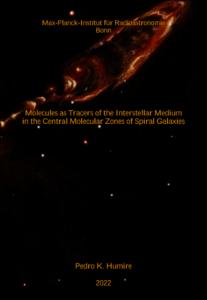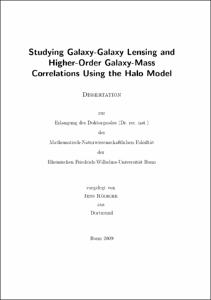Humire, Pedro K.: Molecules as Tracers of the Interstellar Medium in the Central Molecular Zones of Spiral Galaxies. - Bonn, 2023. - Dissertation, Rheinische Friedrich-Wilhelms-Universität Bonn.
Online-Ausgabe in bonndoc: https://nbn-resolving.org/urn:nbn:de:hbz:5-69421
Online-Ausgabe in bonndoc: https://nbn-resolving.org/urn:nbn:de:hbz:5-69421
@phdthesis{handle:20.500.11811/10601,
urn: https://nbn-resolving.org/urn:nbn:de:hbz:5-69421,
author = {{Pedro K. Humire}},
title = {Molecules as Tracers of the Interstellar Medium in the Central Molecular Zones of Spiral Galaxies},
school = {Rheinische Friedrich-Wilhelms-Universität Bonn},
year = 2023,
month = jan,
note = {This thesis is devoted to the investigation of two important astronomical topics related to prevailing conditions in the central molecular zone (CMZ) of spiral galaxies. The first one is based on the analysis of sulfur and carbon rare isotopes, mainly synthesized in massive stars and expelled to the interstellar medium by stellar winds and supernova explosions. Without the contribution of massive stars, our universe would show quite a different kinematics and would be devoid of life, since they are responsible for releasing the most complex elements into the interstellar medium. These elements, heavier than iron, are often recycled by less massive stars that have succeeded them, as is the case of our Sun. The Sun inherited these substances as a second or third generation star, explaining the complex materials present in its surrounding planets. Although hydrogen and helium make up 98% of the baryonic mass in the universe, hydrogen is responsible for only 10% of human being’s compositions. In contrast, 73% of the atoms in the human body are related to material released in exploding massive stars.
The study of sulfur and carbon through its most abundant molecule, carbon monosulfide (CS), is a feasible path to probe what happens inside of stars. By using carbon isotopologue ratios it is possible to prove that the nucleus of our Galaxy is “older” compared to their spiral arms, suporting the inside-out growth scenario of the Galactic Disk. The CS observation also gives us information about the metallicity of the environment in which massive stars reside. The latter is relevant for the refinement of star formation models.
The second topic covered by this work is about the microwave amplification by stimulated emission of radiation (maser lines) from interstellar molecules. While the searching for sulfur across the Milky Way works as an archeologist looking for the previous existence of massive stars, masers occur at early stages of star formation. Masers can originate in a variety of environments, from planetary nebulae to active galactic nuclei. Methanol masers are more restricted in origin and can be used to trace the earliest stages of high-mass star formation. The study of extragalactic methanol masers is a promising new field of research and has great potential to be explored in detail in the coming years.
In the course of this thesis more than 110 (12 m array) and 260 (ACA) hours of integration time have been used from the Atacama Large (sub)millimiter array (ALMA), and more than 60 hours with the Effelsberg telescope. Further ALMA observations have been recycled from the Ph.D. Thesis of Vivien Thiel (2019) and combined with newly observed IRAM 30 m and APEX data.
The main findings of this thesis can be summarized as follows. Regarding the first topic, we have found that the decreasing trend of the 32 S/ 34 S abundance ratio towards the Galactic nucleus is halted somewhere between 1 kpc and ∼130 pc from the galactic center and then reverts to values similar to those encountered in the solar neighborhood. This confirms that the metallicity in the nuclear regions of our Galaxy is similar to the solar one, and indicates a drop in the production of massive stars from the outer limits of our Galaxy until 1 kpc from its nucleus. With respect to the second topic, we have found that methanol masers pumped by shocks are the brightest, and that the conditions required to produce them are weak shocks, generated where entrained material by spiral arms interacts with the nuclear bar. Complementarily, dissociating UV radiation is the most likely explanation for the lack of methanol masers at the very center of spiral galaxies. Quantitatively speaking, we have increased the amount of known galaxies hosting methanol masers beyond the local group: the sample now includes Maffei 2. Furthermore, we have expanded the number of extragalactic methanol maser transitions detected so far from 5 to 11, reporting the first detections at 95, 132, 146, 198, 229, and 278 GHz around the core of NGC 253.},
url = {https://hdl.handle.net/20.500.11811/10601}
}
urn: https://nbn-resolving.org/urn:nbn:de:hbz:5-69421,
author = {{Pedro K. Humire}},
title = {Molecules as Tracers of the Interstellar Medium in the Central Molecular Zones of Spiral Galaxies},
school = {Rheinische Friedrich-Wilhelms-Universität Bonn},
year = 2023,
month = jan,
note = {This thesis is devoted to the investigation of two important astronomical topics related to prevailing conditions in the central molecular zone (CMZ) of spiral galaxies. The first one is based on the analysis of sulfur and carbon rare isotopes, mainly synthesized in massive stars and expelled to the interstellar medium by stellar winds and supernova explosions. Without the contribution of massive stars, our universe would show quite a different kinematics and would be devoid of life, since they are responsible for releasing the most complex elements into the interstellar medium. These elements, heavier than iron, are often recycled by less massive stars that have succeeded them, as is the case of our Sun. The Sun inherited these substances as a second or third generation star, explaining the complex materials present in its surrounding planets. Although hydrogen and helium make up 98% of the baryonic mass in the universe, hydrogen is responsible for only 10% of human being’s compositions. In contrast, 73% of the atoms in the human body are related to material released in exploding massive stars.
The study of sulfur and carbon through its most abundant molecule, carbon monosulfide (CS), is a feasible path to probe what happens inside of stars. By using carbon isotopologue ratios it is possible to prove that the nucleus of our Galaxy is “older” compared to their spiral arms, suporting the inside-out growth scenario of the Galactic Disk. The CS observation also gives us information about the metallicity of the environment in which massive stars reside. The latter is relevant for the refinement of star formation models.
The second topic covered by this work is about the microwave amplification by stimulated emission of radiation (maser lines) from interstellar molecules. While the searching for sulfur across the Milky Way works as an archeologist looking for the previous existence of massive stars, masers occur at early stages of star formation. Masers can originate in a variety of environments, from planetary nebulae to active galactic nuclei. Methanol masers are more restricted in origin and can be used to trace the earliest stages of high-mass star formation. The study of extragalactic methanol masers is a promising new field of research and has great potential to be explored in detail in the coming years.
In the course of this thesis more than 110 (12 m array) and 260 (ACA) hours of integration time have been used from the Atacama Large (sub)millimiter array (ALMA), and more than 60 hours with the Effelsberg telescope. Further ALMA observations have been recycled from the Ph.D. Thesis of Vivien Thiel (2019) and combined with newly observed IRAM 30 m and APEX data.
The main findings of this thesis can be summarized as follows. Regarding the first topic, we have found that the decreasing trend of the 32 S/ 34 S abundance ratio towards the Galactic nucleus is halted somewhere between 1 kpc and ∼130 pc from the galactic center and then reverts to values similar to those encountered in the solar neighborhood. This confirms that the metallicity in the nuclear regions of our Galaxy is similar to the solar one, and indicates a drop in the production of massive stars from the outer limits of our Galaxy until 1 kpc from its nucleus. With respect to the second topic, we have found that methanol masers pumped by shocks are the brightest, and that the conditions required to produce them are weak shocks, generated where entrained material by spiral arms interacts with the nuclear bar. Complementarily, dissociating UV radiation is the most likely explanation for the lack of methanol masers at the very center of spiral galaxies. Quantitatively speaking, we have increased the amount of known galaxies hosting methanol masers beyond the local group: the sample now includes Maffei 2. Furthermore, we have expanded the number of extragalactic methanol maser transitions detected so far from 5 to 11, reporting the first detections at 95, 132, 146, 198, 229, and 278 GHz around the core of NGC 253.},
url = {https://hdl.handle.net/20.500.11811/10601}
}









